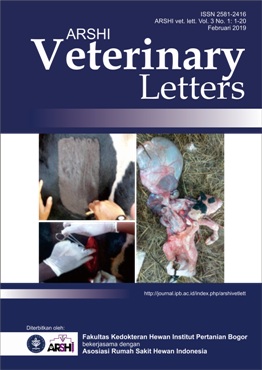Pengetahuan pemilik anjing di kota malang terhadap penyakit zoonosis
Abstract
Anjing merupakan salah satu hewan kesayangan yang dapat menularkan penyakit zoonosis kepada manusia. Pengetahuan pemilik anjing peliharaan akan pencegahan penularan penyakit zoonosis diperlukan agar dapat menurunkan tingkat kejadian penularan penyakit zoonosis dari anjing ke manusia. Studi ini bertujuan untuk mengetahui tingkat pengetahuan dan kesadaran pemilik anjing tentang penyakit zoonosis dan pencegahan penularan penyakit zoonosis dari anjing manusia di Kota Malang. Sebagian besar pemilik anjing di Kota Malang telah mengetahui jenis penyakit zoonosis yang ditularkan oleh anjing ke manusia, dan sebagian besar telah menerapkan cara pencegahan penularan penyakit tersebut. Sebagian besar pemilik hewan telah menerapkan vaksinasi sebagai tindakan pencegahan kejadian penyakit pada anjing.Downloads
References
Abdelmagid OY, Larson L, Payne L, Tubbs A, Wasmoen T, Schultz R. 2004. Evaluation of the efficacy and duration of im-munity of a canine combination vaccine against virulent parvovi-rus, infectious canine hepatitis virus, and distemper virus exper-imental challenges. Veterinary therapeutics: research in applied veterinary medicine. 5(3): 173-186.
Chomel BB. 2014. Emerging and re-emerging zoonoses of dogs and cats. Animals. 4:434-445.
Ghasemzadeh I, Namazi SH. 2015. Review of bacterial and viral zoonotic infection transmitted by dogs. Journal of Medicine and Life. 8(4):1-5.
Khairiyah. 2011. Zoonosis dan upaya pencegahannya (kasus sumatera utara). Jurnal Litbang Pertanian. 30(3): 117-124.
Morters MK, McNabb S, Horton DL, Fooks AR, Schoeman JP, Whay HR, Wood JLN, Cleaveland S. 2015. Effective vaccination againts rabies in puppies in rabies endemic regions. The Veterinary Record. 177(6): 150.
Copyright (c) 2019 CC-BY-SA

This work is licensed under a Creative Commons Attribution-ShareAlike 4.0 International License.
Authors who publish with this journal agree to the following terms:
1. Authors retain copyright and grant the journal right of first publication with the work simultaneously licensed under a Creative Commons Attribution License that allows others to share the work with an acknowledgement of the work's authorship and initial publication in this journal.
2. Authors are able to enter into separate, additional contractual arrangements for the non-exclusive distribution of the journal's published version of the work (e.g., post it to an institutional repository or publish it in a book), with an acknowledgement of its initial publication in this journal.
3. Authors are permitted and encouraged to post their work online (e.g., in institutional repositories or on their website) prior to and during the submission process, as it can lead to productive exchanges, as well as earlier and greater citation of published work (See The Effect of Open Access).


.jpg)















